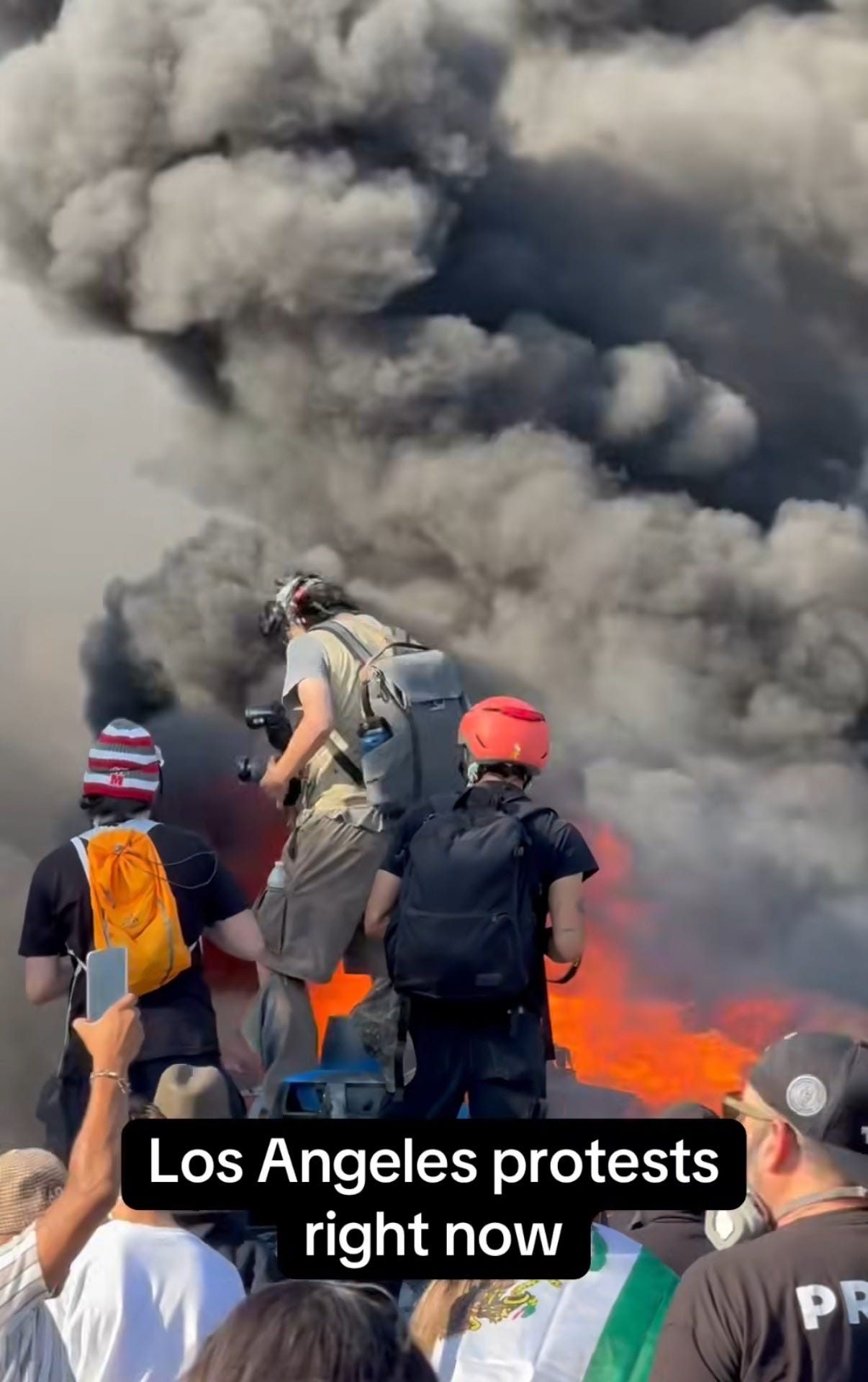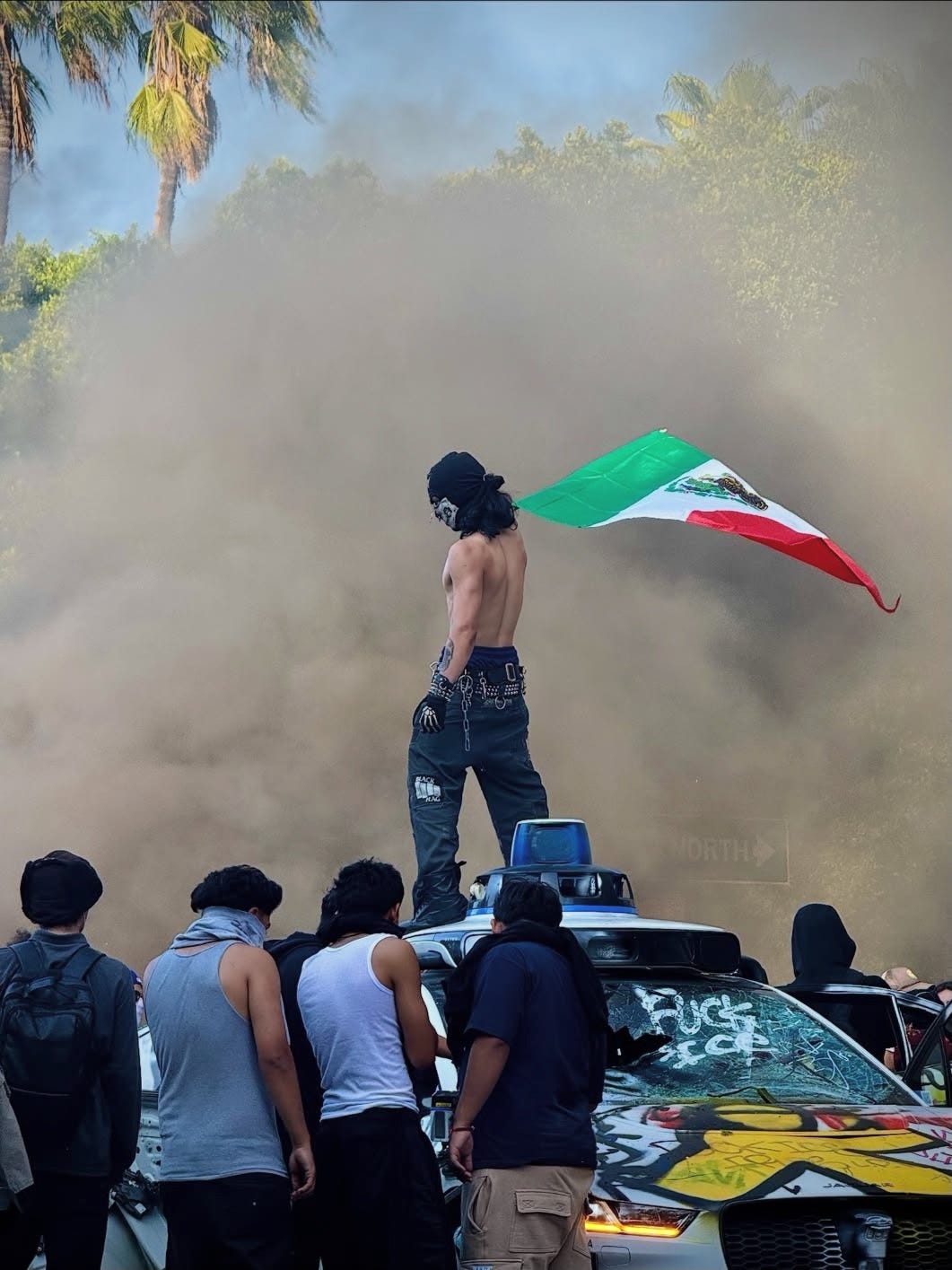C&A: MANUFACTURED CHAOS: How the LA Protests Are Being Twisted to Justify a Police State
Peaceful resistance is being labeled as violence to pave the way for authoritarian control. Don’t fall for the narrative.
For the past several days, downtown Los Angeles has been the site of growing protests aimed at confronting the violent expansion of Immigration and Customs Enforcement (ICE) activity and challenging the broader policies of detention, deportation, and family separation. Protestors—many of them young people, immigrants, and local organizers—gathered near the site of a federal immigration facility to demand an end to inhumane conditions and call attention to what they view as a systemic attack on vulnerable communities.
What began as a peaceful occupation has quickly been reframed by mainstream media outlets as a “riot” or “violent disruption,” despite on-the-ground reports showing a very different reality.
Contrary to the headlines dominating cable news segments, the protests have not been marked by widespread chaos or destruction. In fact, the footage shared by independent journalists and activists paints a picture of determined but peaceful resistance. Organizers set up mutual aid stations. Protestors chanted, held signs, prayed together, and linked arms in front of buses believed to be transporting detained individuals. Tensions only escalated after a sudden and aggressive police response—one that included riot gear, batons, and what appeared to be coordinated attempts to provoke fear and disorder.

So why is the dominant narrative suggesting that this protest was violent and unruly? Why are elected officials and media voices calling for crackdowns and stricter enforcement rather than asking what prompted this public outcry in the first place?
The answer lies in the politics of fear and the deliberate strategy of creating conflict in order to justify authoritarian control. This is not just about LA. It is part of a much larger playbook being executed in plain sight.
Over the past few years, Donald Trump and his close advisor Stephen Miller have made it clear that immigration is not just a political issue, it is a tool they intend to use to consolidate power. From family separation at the border to attempts to end asylum protections, Miller has long pushed a white nationalist vision of America, rooted in exclusion and surveillance. With Trump’s re-election campaign underway, these protests have become a convenient opportunity. By allowing law enforcement to escalate tensions and encouraging media coverage that frames protestors as dangerous, they are attempting to manufacture the very chaos that justifies a police state.
This isn’t speculation. Robert Reich, former U.S. Secretary of Labor, recently warned in his piece The Dictator’s Revenge that we are watching a deliberate attempt to create instability in order to justify authoritarianism. He outlines how Trump and his allies, through Project 2025, plan to expand executive power, ignore judicial rulings, and militarize responses to civil disobedience. Reich identifies two major tipping points into dictatorship: first, when a leader stops honoring the rulings of the courts, and second, when they begin using federal forces to suppress protests. We are now dangerously close to both.
Miller has openly supported policies that increase surveillance of immigrant communities, limit legal pathways to citizenship, and militarize the border. Under his guidance, Trump is now running on a platform that includes mass deportations, the use of military force for domestic crackdowns, and the expansion of detention facilities—many of which are privately owned and profit from incarcerating migrants. Every time protestors push back against this agenda, they are painted as threats to national security. It is a calculated move. If you can make peaceful protest look like a riot, you can then respond with violence and still claim to be restoring order.
The most alarming part is how easily this strategy works. Most Americans do not attend protests. They do not see what actually happens on the ground. Instead, they see a curated set of images and talking points chosen by editors and pundits who rely on sensationalism to drive ratings. When you watch a protest through the lens of a media outlet that has already decided who the enemy is, you are not being informed—you are being manipulated. This is where media literacy becomes not just important, but essential to protecting our democracy.
Independent Journalist Johnny Palmadessa, who has been documenting the protests, put it simply:
“I’ve said it again and again: The protests unfolding in Los Angeles have been consistently peaceful.”
If we want to be a people who value truth, freedom, and justice, we cannot continue to accept the distorted version of events being handed to us by those in power. We have to ask harder questions. We have to listen to the voices of those who are impacted directly by these policies. And we have to stop falling for the narrative that dissent equals danger. It doesn’t. Dissent is the foundation of a free society.
What we are witnessing in Los Angeles is not a riot. It is a cry for justice that is being deliberately twisted into a justification for force.
The stakes are high. If Trump and Miller succeed in reframing every act of protest as lawlessness, they will have the moral cover they need to unleash a wave of state violence under the guise of order. And if the media continues to comply—whether out of laziness, bias, or fear—we will all suffer the consequences.
WHAT EACH SIDE IS SAYING
Mainstream Media
Major networks have described the protests as “erupting into violence,” with some anchors implying that the protestors provoked law enforcement or put federal facilities at risk. Reports often highlight police injuries or damaged property without context or footage of how events escalated.
Right-Wing Media and Politicians
Leaders like Trump have called protestors “radicals” and “illegals,” urging a federal response and referencing the use of the National Guard. Conservative outlets have tied the protests to “open border chaos” and accused protestors of threatening American sovereignty and public safety.
Protestors and Independent Journalists
Firsthand accounts describe the events as largely peaceful, focused on prayer, resistance, and civil disobedience. Protestors say they are resisting the normalization of state-sponsored violence and ICE’s continued targeting of vulnerable immigrant communities. Violence, according to them, began after law enforcement escalated its presence and tactics.
“Don’t be fooled by those lying about the situation.” – @johnnypalmadessa
QUESTIONS FOR DISCERNMENT
Who benefits when protests are framed as riots instead of resistance?
Where are you getting your news—and is it giving you the full picture?
Do you assume protestors are wrong before you listen to their reasons?
Are you more concerned with discomfort or injustice?
Are you aware of Project 2025 and what it means for protest, immigration, and executive power?
SPIRITUAL ANCHOR
As Christians, we are called to be people of truth and justice—not fear and control. Scripture is full of stories where power was used to silence dissent, and Jesus stood with those who were marginalized, misunderstood, and cast aside. He did not align with empire. He did not choose the comfort of the crowd. He stood with the vulnerable and called out those who misused authority in the name of righteousness.
Micah 6:8 reminds us what God requires of us:
“To act justly and to love mercy and to walk humbly with your God.”
This is not a suggestion, it is a command. And it cannot be lived out if we refuse to examine how our systems are failing the very people Christ told us to protect.
The Kingdom of God is not built on barbed wire, border walls, or militarized responses. It is built on compassion, truth, and the radical belief that every person bears the image of God. If we are going to hold the rope for others, we must do so with eyes open and hearts aligned with justice, even when it’s uncomfortable.
Preorders for Living Anchored are coming soon.
If you’ve ever felt too broken, too loud, or too late—you belong in this story.
Make sure you’re subscribed so you don’t miss the release, weekly reflections, and behind-the-scenes updates.
Subscribe to stay rooted. Stay real. Stay anchored.




